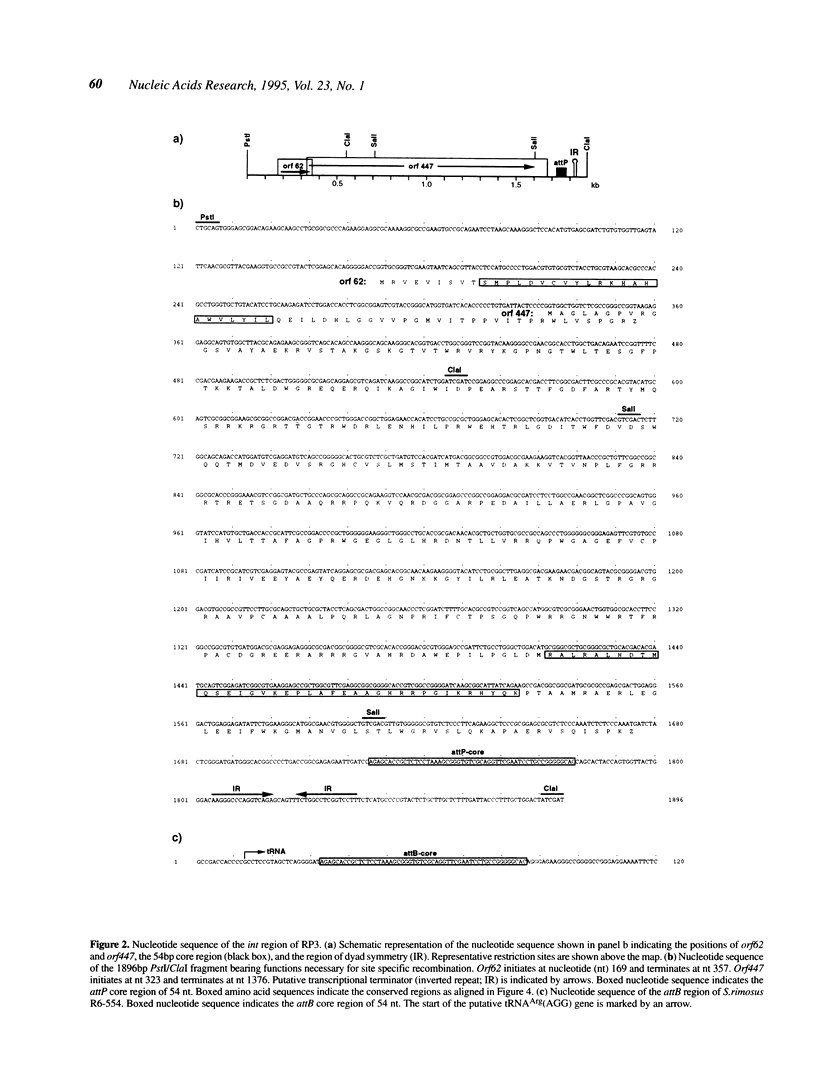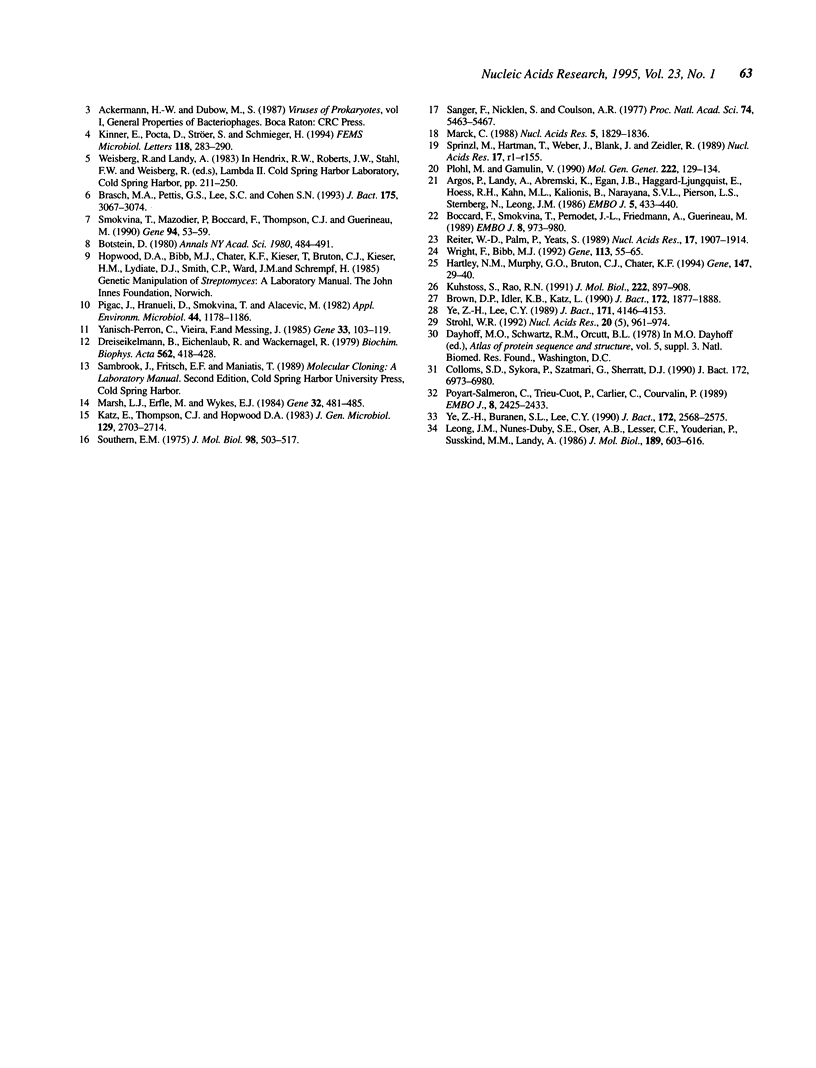Abstract
The temperate actinophage RP3 integrates site-specifically into the chromosome of Streptomyces rimosus R6-554. The phage attachment site attP and the hybrid attachment sites of the integrated prophage--attL and attR--were cloned and sequenced. The 54nt core sequence, common to all RP3 related attachment sites, comprises the 3' terminal end of a putative tRNA(Arg)(AGG) gene. AttB bears the complete tRNA gene which is restored in attL after integration. A 7.5kb HindIII fragment, bearing attP, was used to construct an integrative plasmid to simulate the integration process in vivo and to localize the phage genes necessary for site specific integration. The int and xis genes were sequenced and compared to other recombination genes.
Full text
PDF





Selected References
These references are in PubMed. This may not be the complete list of references from this article.
- Argos P., Landy A., Abremski K., Egan J. B., Haggard-Ljungquist E., Hoess R. H., Kahn M. L., Kalionis B., Narayana S. V., Pierson L. S., 3rd The integrase family of site-specific recombinases: regional similarities and global diversity. EMBO J. 1986 Feb;5(2):433–440. doi: 10.1002/j.1460-2075.1986.tb04229.x. [DOI] [PMC free article] [PubMed] [Google Scholar]
- Boccard F., Smokvina T., Pernodet J. L., Friedmann A., Guérineau M. The integrated conjugative plasmid pSAM2 of Streptomyces ambofaciens is related to temperate bacteriophages. EMBO J. 1989 Mar;8(3):973–980. doi: 10.1002/j.1460-2075.1989.tb03460.x. [DOI] [PMC free article] [PubMed] [Google Scholar]
- Botstein D. A theory of modular evolution for bacteriophages. Ann N Y Acad Sci. 1980;354:484–490. doi: 10.1111/j.1749-6632.1980.tb27987.x. [DOI] [PubMed] [Google Scholar]
- Brasch M. A., Pettis G. S., Lee S. C., Cohen S. N. Localization and nucleotide sequences of genes mediating site-specific recombination of the SLP1 element in Streptomyces lividans. J Bacteriol. 1993 May;175(10):3067–3074. doi: 10.1128/jb.175.10.3067-3074.1993. [DOI] [PMC free article] [PubMed] [Google Scholar]
- Brown D. P., Idler K. B., Katz L. Characterization of the genetic elements required for site-specific integration of plasmid pSE211 in Saccharopolyspora erythraea. J Bacteriol. 1990 Apr;172(4):1877–1888. doi: 10.1128/jb.172.4.1877-1888.1990. [DOI] [PMC free article] [PubMed] [Google Scholar]
- Colloms S. D., Sykora P., Szatmari G., Sherratt D. J. Recombination at ColE1 cer requires the Escherichia coli xerC gene product, a member of the lambda integrase family of site-specific recombinases. J Bacteriol. 1990 Dec;172(12):6973–6980. doi: 10.1128/jb.172.12.6973-6980.1990. [DOI] [PMC free article] [PubMed] [Google Scholar]
- Dreiseikelmann B., Eichenlaub R., Wackernagel W. The effect of differential methylation by Escherichia coli of plasmid DNA and phage T7 and lambda DNA on the cleavage by restriction endonuclease MboI from Moraxella bovis. Biochim Biophys Acta. 1979 May 24;562(3):418–428. doi: 10.1016/0005-2787(79)90105-9. [DOI] [PubMed] [Google Scholar]
- Hartley N. M., Murphy G. O., Bruton C. J., Chater K. F. Sequence of the essential early region of phi C31, a temperate phage of Streptomyces spp. with unusual features in its lytic development. Gene. 1994 Sep 15;147(1):29–40. doi: 10.1016/0378-1119(94)90035-3. [DOI] [PubMed] [Google Scholar]
- Hranueli D., Pigac J., Vesligaj M. Characterization and persistence of actinophage RP2 isolated from Streptomyces rimosus ATCC 10970. J Gen Microbiol. 1979 Oct;114(2):295–303. doi: 10.1099/00221287-114-2-295. [DOI] [PubMed] [Google Scholar]
- Katz E., Thompson C. J., Hopwood D. A. Cloning and expression of the tyrosinase gene from Streptomyces antibioticus in Streptomyces lividans. J Gen Microbiol. 1983 Sep;129(9):2703–2714. doi: 10.1099/00221287-129-9-2703. [DOI] [PubMed] [Google Scholar]
- Kinner E., Pocta D., Ströer S., Schmieger H. Sequence analysis of cohesive ends of the actinophage RP3 genome and construction of a transducible shuttle vector. FEMS Microbiol Lett. 1994 May 15;118(3):283–289. doi: 10.1111/j.1574-6968.1994.tb06842.x. [DOI] [PubMed] [Google Scholar]
- Kuhstoss S., Rao R. N. Analysis of the integration function of the streptomycete bacteriophage phi C31. J Mol Biol. 1991 Dec 20;222(4):897–908. doi: 10.1016/0022-2836(91)90584-s. [DOI] [PubMed] [Google Scholar]
- Leong J. M., Nunes-Düby S. E., Oser A. B., Lesser C. F., Youderian P., Susskind M. M., Landy A. Structural and regulatory divergence among site-specific recombination genes of lambdoid phage. J Mol Biol. 1986 Jun 20;189(4):603–616. doi: 10.1016/0022-2836(86)90491-2. [DOI] [PubMed] [Google Scholar]
- Marck C. 'DNA Strider': a 'C' program for the fast analysis of DNA and protein sequences on the Apple Macintosh family of computers. Nucleic Acids Res. 1988 Mar 11;16(5):1829–1836. doi: 10.1093/nar/16.5.1829. [DOI] [PMC free article] [PubMed] [Google Scholar]
- Marsh J. L., Erfle M., Wykes E. J. The pIC plasmid and phage vectors with versatile cloning sites for recombinant selection by insertional inactivation. Gene. 1984 Dec;32(3):481–485. doi: 10.1016/0378-1119(84)90022-2. [DOI] [PubMed] [Google Scholar]
- Pigac J., Hranueli D., Smokvina T., Alacević M. Optimal Cultural and Physiological Conditions for Handling Streptomyces rimosus Protoplasts. Appl Environ Microbiol. 1982 Nov;44(5):1178–1186. doi: 10.1128/aem.44.5.1178-1186.1982. [DOI] [PMC free article] [PubMed] [Google Scholar]
- Plohl M., Gamulin V. Five transfer RNA genes lacking CCA termini are clustered in the chromosome of Streptomyces rimosus. Mol Gen Genet. 1990 Jun;222(1):129–134. doi: 10.1007/BF00283033. [DOI] [PubMed] [Google Scholar]
- Poyart-Salmeron C., Trieu-Cuot P., Carlier C., Courvalin P. Molecular characterization of two proteins involved in the excision of the conjugative transposon Tn1545: homologies with other site-specific recombinases. EMBO J. 1989 Aug;8(8):2425–2433. doi: 10.1002/j.1460-2075.1989.tb08373.x. [DOI] [PMC free article] [PubMed] [Google Scholar]
- Rausch H., Vesligaj M., Pocta D., Biuković G., Pigac J., Cullum J., Schmieger H., Hranueli D. The temperate phages RP2 and RP3 of Streptomyces rimosus. J Gen Microbiol. 1993 Oct;139(10):2517–2524. doi: 10.1099/00221287-139-10-2517. [DOI] [PubMed] [Google Scholar]
- Reiter W. D., Palm P., Yeats S. Transfer RNA genes frequently serve as integration sites for prokaryotic genetic elements. Nucleic Acids Res. 1989 Mar 11;17(5):1907–1914. doi: 10.1093/nar/17.5.1907. [DOI] [PMC free article] [PubMed] [Google Scholar]
- Sanger F., Nicklen S., Coulson A. R. DNA sequencing with chain-terminating inhibitors. Proc Natl Acad Sci U S A. 1977 Dec;74(12):5463–5467. doi: 10.1073/pnas.74.12.5463. [DOI] [PMC free article] [PubMed] [Google Scholar]
- Smokvina T., Mazodier P., Boccard F., Thompson C. J., Guérineau M. Construction of a series of pSAM2-based integrative vectors for use in actinomycetes. Gene. 1990 Sep 28;94(1):53–59. doi: 10.1016/0378-1119(90)90467-6. [DOI] [PubMed] [Google Scholar]
- Southern E. M. Detection of specific sequences among DNA fragments separated by gel electrophoresis. J Mol Biol. 1975 Nov 5;98(3):503–517. doi: 10.1016/s0022-2836(75)80083-0. [DOI] [PubMed] [Google Scholar]
- Sprinzl M., Hartmann T., Weber J., Blank J., Zeidler R. Compilation of tRNA sequences and sequences of tRNA genes. Nucleic Acids Res. 1989;17 (Suppl):r1–172. doi: 10.1093/nar/17.suppl.r1. [DOI] [PMC free article] [PubMed] [Google Scholar]
- Strohl W. R. Compilation and analysis of DNA sequences associated with apparent streptomycete promoters. Nucleic Acids Res. 1992 Mar 11;20(5):961–974. doi: 10.1093/nar/20.5.961. [DOI] [PMC free article] [PubMed] [Google Scholar]
- Wright F., Bibb M. J. Codon usage in the G+C-rich Streptomyces genome. Gene. 1992 Apr 1;113(1):55–65. doi: 10.1016/0378-1119(92)90669-g. [DOI] [PubMed] [Google Scholar]
- Yanisch-Perron C., Vieira J., Messing J. Improved M13 phage cloning vectors and host strains: nucleotide sequences of the M13mp18 and pUC19 vectors. Gene. 1985;33(1):103–119. doi: 10.1016/0378-1119(85)90120-9. [DOI] [PubMed] [Google Scholar]
- Ye Z. H., Buranen S. L., Lee C. Y. Sequence analysis and comparison of int and xis genes from staphylococcal bacteriophages L54a and phi 11. J Bacteriol. 1990 May;172(5):2568–2575. doi: 10.1128/jb.172.5.2568-2575.1990. [DOI] [PMC free article] [PubMed] [Google Scholar]
- Ye Z. H., Lee C. Y. Nucleotide sequence and genetic characterization of staphylococcal bacteriophage L54a int and xis genes. J Bacteriol. 1989 Aug;171(8):4146–4153. doi: 10.1128/jb.171.8.4146-4153.1989. [DOI] [PMC free article] [PubMed] [Google Scholar]


